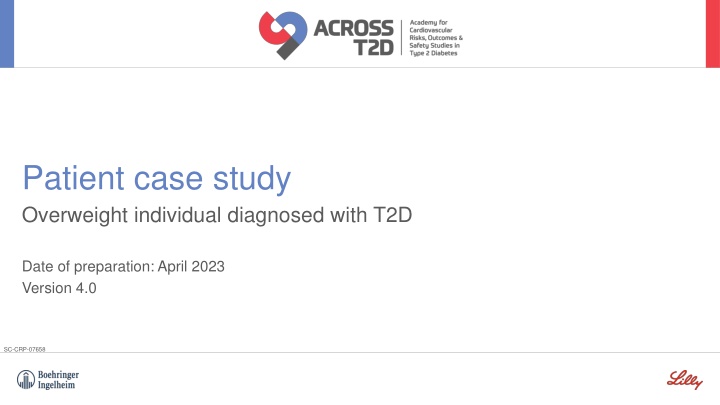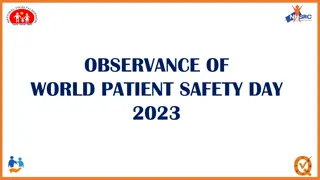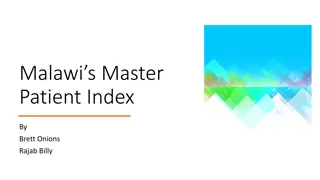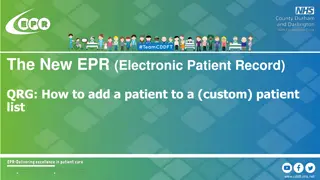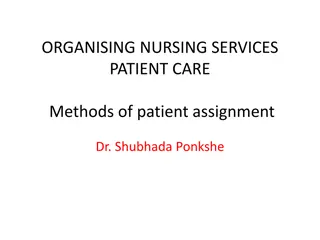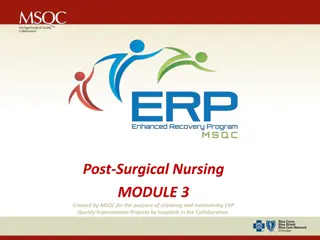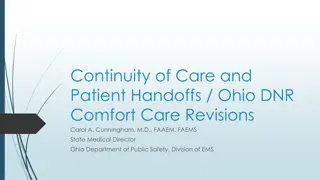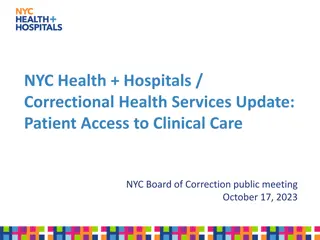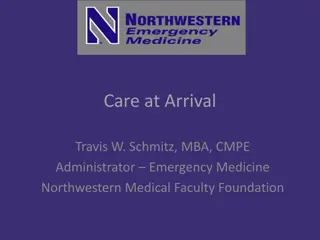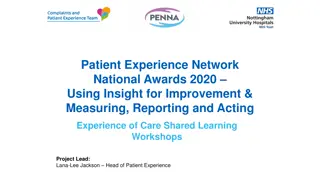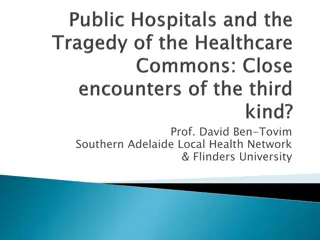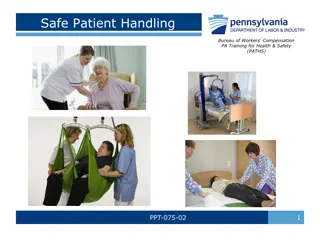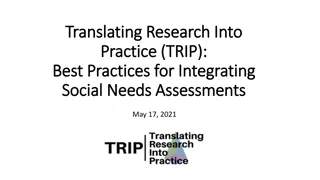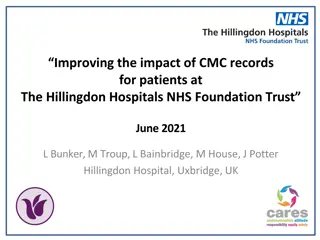Patient case study
This patient case study focuses on a 50-year-old male diagnosed with Type 2 Diabetes (T2D) and overweight concerns. Follow Robert through his PCP appointments, medical history, lifestyle factors, and presenting complaints. Dive into discussions on weight management, fatigue, and sleep disturbances in this interactive learning experience.
Download Presentation

Please find below an Image/Link to download the presentation.
The content on the website is provided AS IS for your information and personal use only. It may not be sold, licensed, or shared on other websites without obtaining consent from the author.If you encounter any issues during the download, it is possible that the publisher has removed the file from their server.
You are allowed to download the files provided on this website for personal or commercial use, subject to the condition that they are used lawfully. All files are the property of their respective owners.
The content on the website is provided AS IS for your information and personal use only. It may not be sold, licensed, or shared on other websites without obtaining consent from the author.
E N D
Presentation Transcript
Patient case study Overweight individual diagnosed with T2D Date of preparation: April 2023 Version 4.0 SC-CRP-07658
Disclaimer This patient case is hypothetical and has been developed in collaboration with Professor Cliff Bailey (Aston University, UK) The statements reflect recommendations and suggestions from the ACROSS T2D Steering Committee for this specific clinical case and do not necessarily represent the opinions of The Boehringer Ingelheim and Lilly Alliance Any data mentioned herein may be abbreviated and not exact 2
How to use this case study Robert 50-year-old male This interactive patient case study is designed as a self-learning experience or to be incorporated into presentations and workshops. It has been developed to reflect a typical patient under the care of a PCP Please follow Robert over the course of two sequential appointments and consider the multiple-choice questions to assess appropriate management steps 3 PCP, primary care physician
Robert Robert Robert is a 50-year-old male who is concerned about feeling tired and sleeping poorly. This is Robert s first appointment with a PCP. You ask Robert about his presenting complaints, his medical history and his current lifestyle. Robert is not a real patient PCP, primary care physician 4
Robert PCP visit 1 Robert appointment 1 Feels exhausted Has to get up frequently at night to urinate Presenting complaints He has been overweight since his twenties; his weight continued to increase throughout his forties Not currently on any medication No history of major illness Robert s father suffered from an MI at the age of 48 years Medical history Robert is a software developer. He works from home and frequently sits at his desk for up to 10 hours per day By watching his food intake, Robert has lost 7 kg over the last 4 months Lifestyle factors 5 CHD, coronary heart disease; PCP, primary care physician
Robert PCP visit 1 You conduct a physical examination Robert s test results Weight: 97 kg Observations and examinations Height: 182 cm BMI: 29.3 kg/m2 CV and respiratory examination: normal Systolic/diastolic BP: 145/96 mmHg Click here to show normal values Click here to show normal values 6 PCP, primary care physician
Robert PCP visit 1 You review the results of Robert s physical examination Normal or target range1 3 Robert s test results Weight: 97 kg Weight: NA Observations and examinations Height: 182 cm Height: NA BMI: 29.3 kg/m2 BMI1,2: 20 25 kg/m2 CV and respiratory examination: normal CV and respiratory examination: NA Systolic/diastolic BP: 145/96 mmHg Systolic/diastolic BP3: <130/80 mmHg Management considerations You order a blood test for Robert and inform him that you will call once you receive the results NA, not applicable; PCP, primary care physician 1. Mach F et al. Eur Heart J 2020;41:111; 2. American Diabetes Association. Diabetes Care 2023;46:S1; 3. Cosentino F et al. Eur Heart J 2020;41:255 7
Robert PCP visit 1 and follow-up blood test results You review Robert s recent blood test results Robert s test results FPG*: 8.9 mmol/l (160 mg/dl) HbA1c: 8.4% (68 mmol/mol) LDL-C: 3.05 mmol/l (118 mg/dl) Blood test results HDL-C: 1.3 mmol/l (50 mg/dl) Triglycerides: 1.41 mmol/l (125 mg/dl) Total cholesterol: 5.6 mmol/l (218 mg/dl) eGFR: 85 ml/min/1.73 m2 UACR: 28 mg/g Random plasma glucose: 11.9 mmol/l (215 mg/dl) Click here to show normal range Click here to show normal range *Fasting defined as no caloric intake for at least 8 hours1 FPG, fasting plasma glucose; PCP, primary care physician 1. American Diabetes Association. Diabetes Care 2023;46:S1 8
Robert PCP visit 1 and follow-up blood test results You review Robert s recent blood test results Normal or target range Robert s test results FPG*: 8.9 mmol/l (160 mg/dl) FPG*1: <5.6 mmol/l (100 mg/dl) HbA1c: 8.4% (68 mmol/mol) HbA1c1: <7.0% (53 mmol/mol) LDL-C: 3.05 mmol/l (118 mg/dl) LDL-C2 4: <1.4 mmol/l (55 mg/dl) if at very high CV risk; <1.8 mmol/l (70 mg/dl) if at high CV risk; <2.6 mmol/l (100 mg/dl) if at moderate CV risk Blood test results HDL-C: 1.3 mmol/l (50 mg/dl) HDL-C1: >0.9 mmol/l ( 35 mg/dl) Triglycerides: 1.41 mmol/l (125 mg/dl) Triglycerides2,3: <1.7 mmol/l (150 mg/dl) Total cholesterol: 5.6 mmol/l (218 mg/dl) Total cholesterol2: <3.9 mmol/l (~150 mg/dl) eGFR: 85 ml/min/1.73 m2 eGFR5: 90 ml/min/1.73 m2 UACR: 28 mg/g UACR5: <30 mg/g Random plasma glucose: 11.9 mmol/l (215 mg/dl) Random plasma glucose1: <11.1 mmol/l (200 mg/dl) You confirm that Robert has T2D and you call to inform him immediately to discuss treatment options Management considerations *Fasting defined as no caloric intake for at least 8 hours1 FPG, fasting plasma glucose; PCP, primary care physician 1. American Diabetes Association. Diabetes Care 2023;46:S1; 2. Centers for Disease Control and Prevention. Getting your cholesterol checked. 2022. https://www.cdc.gov/ (accessed Feb 2023); 3. Mach F et al. Eur Heart J 2020;41:111; 4. Cosentino F et al. Eur Heart J 2020;41:255; 5. Kidney Disease: Improving Global Outcomes (KDIGO) Diabetes Work Group. Kidney Int 2022;102:S1 9
Robert PCP visit 1 Robert s management plan You and Robert discuss his treatment options: You explain to Robert that achieving glycaemic control should be pursued as part of a multifactorial CV risk reduction framework1,2 Approximately one in three people with T2D have CV disease3 Robert has a high risk of CV disease due to his family history of premature CHD, as well as his high BMI, hypertension and increased cholesterol levels Although Robert's kidney function is classified as normal, his eGFR is slightly reduced Robert emphasises to the doctor that he does not wish to take too many medications to begin with Management considerations CHD, coronary heart disease; PCP, primary care physician 1. American Diabetes Association. Diabetes Care 2023;46:S1; 2. Cosentino F et al. Eur Heart J 2020;41:255; 3. International Diabetes Foundation. Diabetes Atlas 2019 9th Edition. http://www.diabetesatlas.org (accessed Feb 2023) 10
Robert PCP visit 1 Robert s management plan Which of the following treatment options is appropriate for Robert in addition to lifestyle changes? 1. No pharmacological therapy (lifestyle changes only) 1. No pharmacological therapy (lifestyle changes only) 6. SGLT2 inhibitor monotherapy 6. SGLT2 inhibitor monotherapy 2. Basal insulin 7. GLP-1 RA monotherapy 2. Basal insulin 7. GLP-1 RA monotherapy 3. Metformin monotherapy 8. DPP-4 inhibitor 3. Metformin monotherapy 8. DPP-4 inhibitor 4. Sulphonylurea 9. Thiazolidinedione 4. Sulphonylurea 9. Thiazolidinedione 5. Metformin combination therapy 5. Metformin combination therapy 11 PCP, primary care physician
Robert PCP visit 1 Robert s management plan Answer selected: No pharmacological therapy (lifestyle changes only) Robert has inadequate glycaemic and lipid control, as well as high BP It is recommended that the PCP establishes weight loss goals and intervention strategies with the individual with T2D1 However, diet and exercise alone are likely not sufficient for the immediate management of T2D Weight loss of >5% is needed to improve glycaemic control, lipid levels and BP for many obese people with T2D1,2 Robert's test results showed his LDL-C levels were >3 mmol/l and HbA1c was at 8.4%, which suggests pharmacological therapy is required to address his high lipid and HbA1c levels The doctor and Robert both agree that physical activity and watching his diet are important but they decide that additional therapy is required Click here to go back Click here to go back PCP, primary care physician 1. American Diabetes Association. Diabetes Care 2023;46:S1; 2. Cosentino F et al. Eur Heart J 2020;41:255 12
Robert PCP visit 1 Robert s management plan Answer selected: Basal insulin Insulin has the highest efficacy for lowering HbA1c but it can result in weight gain, carries a high risk of hypoglycaemia and offers little additional benefit for reducing the risk of CV events1,2 Robert expresses concerns about the weight gain and injection burden associated with insulin When choosing a glucose-lowering therapy for overweight people with T2D, it is recommended to consider the medication's effect on weight1 Basal insulin1 Efficacy High to very high Hypoglycaemia risk Yes (all insulins pose a hypoglycaemia risk) Weight change Gain Side effects Injection site reactions Higher risk of hypoglycaemia with human insulin (NPH or premixed formulations) vs analogues Cost Low cost for human insulin CV effects in T2D Neutral Kidney effects in T2D Neutral Together, the doctor and Robert decide upon a different option Click here to go back Click here to go back NPH, Neutral Protamine Hagedorn; PCP, primary care physician 1. American Diabetes Association. Diabetes Care 2023;46:S1; 2. Cosentino F et al. Eur Heart J 2020;41:255 13
Robert PCP visit 1 Robert s management plan Answer selected: Metformin monotherapy Metformin monotherapy1 Pharmacological approaches that provide adequate efficacy to achieve and maintain treatment goals should be considered, such as metformin or other agents, including combination therapy*1 Efficacy High Hypoglycaemia risk No Weight change Neutral (potential for modest loss) Side effects GI side effects common; to mitigate GI side effects, consider slow dose titration, extended release formulations, and administration with food Potential for vitamin B12 deficiency; monitor at regular intervals Provided that lifestyle measures (diet and exercise) are explained and adopted by the individual, metformin can be started at the time of T2D diagnosis unless there are contraindications and as long as it is well tolerated1 Cost Low CV effects in T2D Possible benefit for effect on MACE, neutral for HF The doctor and Robert both decide that this is the best option for now given Robert s new diagnosis and personal preference, along with a statin to address his high LDL-C level and a BP-lowering medication for his high BP Kidney effects in T2D Neutral Click here to go back Correct answer Click here to go back Correct answer *This advice may differ between diabetes guidelines; the AACE/ACE Consensus Statement recommends metformin plus another agent in addition to lifestyle therapy for individuals with HbA1c >7.5%2; Please refer to local prescribing information. See slide notes for abbreviations and reference list 14
Robert PCP visit 1 Robert s management plan Answer selected: SGLT2 inhibitor monotherapy SGLT2 inhibitor1 An SGLT2 inhibitor with proven CV benefit is recommended for people with T2D who are at high CV risk, independent of HbA1c1 Efficacy Intermediate to high Hypoglycaemia No SGLT2 inhibitors reduce weight, BP and albuminuria through mechanisms that appear independent of glycaemic effects1 Weight change Loss (intermediate) Side effects DKA risk, rare in T2D: discontinue, evaluate, and treat promptly if suspected* Increased risk of genital mycotic infections Necrotizing fasciitis of the perineum (Fournier gangrene), rare reports. Institute prompt treatment if suspected Attention to volume status, blood pressure; adjust other volume-contracting agents as applicable Considering the individual s moderate albuminuria and increased risk for CV disease, an SGLT2 inhibitor would be appropriate for Robert Robert has normal to mildly increased UACR, mildly decreased eGFR, elevated BMI, BP and LDL-C levels, as well as a family history of CV disease Cost High CV effects in T2D Benefit for effect on MACE (empagliflozin and canagliflozin) and HF (empagliflozin, canagliflozin, dapagliflozin and ertugliflozin) The doctor and Robert discuss the potential progression of T2D and the complications that might arise such as CV and kidney disease. Together, they decide that SGLT2 inhibitors may not be the preferred option given that SGLT2 inhibitor monotherapy is indicated for T2D treatment (as an adjunct to diet and exercise) when metformin is considered inappropriate due to intolerance2-4 Kidney effects in T2D Benefit: canagliflozin, empagliflozin, dapagliflozin Click here to go back Click here to go back For agent-specific recommendations, please refer to the manufacturers prescribing information *Be aware of predisposing risk factors and clinical presentation (including euglycaemic DKA); discontinue before scheduled surgery (3 4 days), during critical illness, or during prolonged fasting to mitigate potential risk; Empagliflozin was evaluated in the EMPA-REG OUTCOME study, canagliflozin was evaluated in the CREDENCE study, and dapagliflozin was evaluated in the DECLARE-TIMI 58 study.1 DKA, diabetic ketoacidosis; PCP, primary care physician. See slide notes for references 15
Robert PCP visit 1 Robert s management plan Answer selected: GLP-1 RA monotherapy GLP-1 RA1 Adding a GLP-1 RA with proven CV disease benefit may lower his HbA1c level, reduce his weight and provide additional CV protection1 A GLP-1 RA could be considered for Robert because he has T2D, indicators of high risk for ASCVD and is overweight. However, SC injections* and possible GI side effects deterred Robert from this option Efficacy High to very high Hypoglycaemia No Weight change Loss (intermediate to very high) Side effects Rare risk of thyroid C-cell tumours in rodents (liraglutide, dulaglutide, exenatide extended release, semaglutide) Counsel individuals on potential for GI side effects and their typically temporary nature; provide guidance on dietary modifications to mitigate GI side effects Pancreatitis has been reported in clinical trials but causality has not been established. Discontinue if pancreatitis is suspected Evaluate for gallbladder disease if cholelithiasis or cholecystitis is suspected Cost High The doctor and Robert discuss the potential progression of T2D and the complications that might arise such as CV and kidney disease, and decide that GLP-1 RAs may not be the preferred option given Robert s preference for oral therapy CV effects in T2D Benefit or neutral for effect on MACE ; neutral for HF Kidney effects in T2D Benefit for kidney endpoints in CVOTs, driven by albuminuria outcomes: dulaglutide, liraglutide, semaglutide (SC) Click here to go back Click here to go back For agent-specific recommendations, please refer to the manufacturers prescribing information *Except for oral semaglutide; Reduction in meal size, mindful eating practices (stop eating once full, decreasing intake of high-fat or spicy food), consider slower dose titration for individuals experiencing GI challenges; Benefit: dulaglutide, liraglutide, semaglutide (SC). Neutral: exenatide (qw), lixisenatide GI, gastrointestinal; PCP, primary care physician; SC, subcutaneous 1. American Diabetes Association. Diabetes Care 2023;46:S1 16
Robert PCP visit 1 Robert s management plan Answer selected: Sulphonylurea, metformin combination, DPP-4 inhibitor, thiazolidinedione Sulphonylureas tend to increase weight, which may not be appropriate for Robert1 Sulphonylurea Initial combination therapy should be considered when HbA1c is 1.5-2% above target.1 Some guidelines suggest that an initial HbA1c of >7.5% warrants consideration of an initial combination therapy,2 but Robert emphasised that he does not wish to take too many medications to start with* Metformin combination DPP-4 inhibitors are weight neutral; an alternative option may be more appropriate1 DPP-4 inhibitor Thiazolidinediones tend to increase weight, which may not be appropriate for Robert1 Thiazolidinedione Together, the doctor and Robert decide upon a different option Click here to go back Click here to go back For agent-specific recommendations, please refer to the manufacturers prescribing information *An extended-release formulation of metformin may also help to decrease pill burden and dosing complexity. See slide notes for abbreviations and reference list 17
Robert PCP visit 1 Target for glycaemic control Which of the following glycaemic targets is appropriate for Robert? <6.0% 6.0 6.5% 6.5 7.0% 7.0 7.5% <6.0% 6.0 6.5% 6.5 7.0% 7.0 7.5% 18 PCP, primary care physician
Robert PCP visit 1 Target for glycaemic control Which of the following glycaemic targets is appropriate for Robert? <6.0% 6.0 6.5% 6.5 7.0% 7.0 7.5% For most adults, an HbA1c goal of <7% is appropriate1,2 On the basis of judgement by the doctor and patient preference, a goal of HbA1c <6.5% may be acceptable if it can be achieved safely without significant hypoglycaemia1 Robert does not have other concomitant illnesses and he is newly diagnosed with T2D Robert and his doctor decide that an HbA1c goal of 6.0 6.5% is reasonable and attainable over the next 3 months until Robert s follow-up appointment PCP, primary care physician 1. American Diabetes Association. Diabetes Care 2023;46:S1; 2. Cosentino F et al. Eur Heart J 2020;41:255 19
Robert PCP visit 1 Monitoring of glycaemic control Which of the following options is the most appropriate for monitoring Robert s blood glucose level? 1. HbA1c test after 3 months of treatment 2. Daily SMBG levels 3. Both daily SMBG levels and HbA1c test after 3 months 1. HbA1c test after 3 months of treatment 3. Both daily SMBG levels and HbA1c test after 3 months 2. Daily SMBG levels 20 PCP, primary care physician; SMBG, self-monitoring of blood glucose
Robert PCP visit 1 Monitoring of glycaemic control Which of the following options is the most appropriate for monitoring Robert s blood glucose level? 1. HbA1c test after 3 months of treatment 3. Both daily SMBG levels and HbA1c test after 3 months 2. Daily SMBG levels The HbA1c test should be performed quarterly for Robert because he is starting a new glucose-lowering therapy and the doctor will need to determine whether metformin is well tolerated and effective in this individual1 SMBG may help with self-management when altering diet, physical activity and/or medications1 Daily SMBG will provide an early indication of whether the treatment with metformin is effective and will enable appropriate dose titration The doctor advises Robert on how to take the metformin and to monitor his blood glucose (preferably once each week to inform dose titration) and schedules a follow-up visit for 3 months from now to assess the efficacy of metformin for reducing Robert s blood glucose and HbA1c level BG, blood glucose; PCP, primary care physician; SMBG, self-monitoring of blood glucose 1. American Diabetes Association. Diabetes Care 2023;46:S1 21
Diabetes requires multifactorial management of cardio-renal and metabolic risk factors beyond glycaemic control1,2 ADA and ESC guidelines focus on early intervention to reduce the risk of CV and kidney events in people with T2D1,2 Target Treatment Metformin, SGLT2 inhibitors,* GLP-1 receptor agonists, DPP-4 inhibitors, sulphonylureas, thiazolidinediones, insulin1,2 Targets are individualised for many individuals HbA1c <7%1,2 Glucose control For individuals with T2D and hypertension, a BP target of: <130/80 mmHg if it can be safely attained 1 RAAS blocker (ACE inhibitor/ARB), CCB, thiazide-like diuretics1,2 Dual therapy is recommended as first-line treatment1,2 BP lowering <1.4 mmol/l (<55 mg/dl) with LDL-C reduction of 50% if at very high CV risk2 <1.8 mmol/l (<70 mg/dl) with LDL-C reduction of 50% if at high CV risk1,2 <2.6 mmol/l (<100 mg/dl) if at moderate CV risk2 LDL-C lowering Statins, ezetimibe or PCSK9 inhibitor1,2 Smoking cessation, weight loss and physical activity targets of1,2: In individuals who are overweight or obese, a 5% weight loss is needed to improve glycaemic control, lipid levels and BP 150 min/week of moderate to vigorous-intensity combined aerobic and resistance training Individualised diet and lifestyle Nutrition,1,2 physical activity1,2 and behavioural therapy1 T2D and hypertension: ACE inhibitor or ARB when eGFR <60 ml/min/1.73 m2 and/or UACR 30 mg/g1 T2D where CKD predominates: SGLT2 inhibitors should be preferentially considered to reduce the risk of CKD progression and CV events, independently of HbA1c 1 In people with T2D and established CKD, UACR and eGFR should be monitored 1 4 times per year depending on the stage of the disease1 Kidney function For agent-specific recommendations, please refer to the manufacturers prescribing information. For full recommendations, please refer to the individual references. *Empagliflozin, canagliflozin and dapagliflozin reduce CV events in people with diabetes and CV disease or who are at very high/high CV risk; Liraglutide, semaglutide and dulaglutide reduce CV events in people with diabetes and CV disease or who are at very high/high CV risk; The ESC guidelines recommend a BP target of 130/<80 mmHg but not <120/70 mmHg for people with diabetes unless >65 years old2; Additional weight loss usually results in further improvements in the management of diabetes and CV risks; In people with eGFR of 20 ml/min/1.73 m2and UACR >30 mg/g, particularly UACR 200 mg/g. Please see slide notes for abbreviations and references 22
There are several treatment options ranked by level of efficacy for glycaemic and weight management for people with T2D To avoid therapeutic inertia reassess and modify treatment regularly (3 6 months) ADA 2023 Standards of Medical Care and ADA EASD Consensus Report1,2: Goal achievement and maintenance of glycaemic and weight management goals Glycaemia management: choose approaches that provide the efficacy to achieve goals Achievement and management of weight-management goals Set individualised weight-management goals and consider: Lifestyle advice Medication for weight loss Metabolic surgery Weight-management programme Metformin OR agent(s) including combination therapy that provide adequate efficacy to achieve and maintain goals Consider a glucose-lowering regimen with high-to-very-high dual glucose and weight efficacy Consider avoidance of hypoglycaemia a priority in high-risk individuals Efficacy for glucose lowering Efficacy for weight loss Very high: Dulaglutide (high dose), semaglutide, tirzepatide Insulin, combination oral, combination injectable (GLP-1 RA/insulin) High: GLP-1 RA (not listed above), metformin, SGLT2 inhibitor, sulphonylurea, TZD Very high: Semaglutide, tirzepatide High: Dulaglutide, liraglutide Intermediate: GLP-1 RA (not listed above), SGLT2 inhibitor Intermediate: DPP-4i Neutral: DPP-4i, metformin Identify barriers to goals if HbA1c is above target Figure adapted from the ADA-EASD consensus report. Davies MJ et al. Diabetes Care 2022;45:2753. There are additional recommendations If HbA1c remains above target; for full recommendations, please refer to the reference. TZD, thiazolidinedione. 1. American Diabetes Association. Diabetes Care 2023;46:S1; 2. Davies MJ et al. Diabetes Care 2022;45:2753 23
SGLT2 inhibitors are recommended as a first-line treatment option in the management of people with T2D at high risk of cardio-renal events To avoid therapeutic inertia, reassess and modify treatment regularly (3 6 months) ADA 2023 Standards of Medical Care and ADA EASD Consensus Report1,2: Goal cardio-renal risk reduction in high-risk people with T2D*, +ASCVD/indicators of high risk +CKD +HF People with HF People with ASCVD/indicators of high risk GLP-1 RA with proven CVD benefit People with CKD (on maximally tolerated dose of ACEi/ARB) Preferably SGLT2 inhibitor with primary evidence of reducing CKD progression SGLT2 inhibitor with proven CVD benefit GLP-1 RA with proven CV benefit if SGLT2 inhibitor not tolerated or contraindicated Either/ or SGLT2 inhibitor with proven benefit in this population Use SGLT2 inhibitor in people with an eGFR 20 ml/min per 1.73 m2; once initiated, should be continued until dialysis or transplantation If HbA1c above target Or For individuals on a GLP-1 RA consider adding SGLT2 inhibitor with proven CVD benefit or vice versa TZD** If HbA1c above target, for individuals on SGLT2 inhibitor, consider incorporating a GLP-1 RA or vice versa Identify barriers to goals if additional cardio-renal risk reduction or glycaemic-lowering needed Figure adapted from ADA-EASD consensus report. Davies MJ et al. Diabetes Care 2022;45:2753. There are additional recommendations If HbA1c remains above target; for full recommendations, please refer to the reference. For full recommendations, please refer to the reference Please see speaker notes for footnotes, abbreviations and references 24
Robert PCP visit 1 Additional management considerations Other examinations for people newly diagnosed with T2D: Micro-/macrovascular complications: Blood pressure: Robert is hypertensive (145/96 mmHg) Hypertension is a major risk factor for both ASCVD and microvascular complications1 It is important that the PCP initiates treatment for Robert's elevated BP (along with lifestyle changes) Comprehensive foot examination: All individuals newly diagnosed with T2D should be assessed for diabetic peripheral neuropathy1,2 The PCP should perform a comprehensive foot examination at least annually1,2 Lipid management: Robert has an elevated level of LDL-C (3.05 mmol/l) A moderate-intensity statin therapy, such as atorvastatin 10 mg,is recommended for people with diabetes and a high LDL-C level, who are aged 40 75 years without ASCVD1,2 Eye examination: Individuals with newly diagnosed T2D should have an initial comprehensive eye examination by an ophthalmologist or optometrist at the time of diagnosis1 Kidney function: Robert has signs of mildly decreased kidney function (eGFR: 85 ml/min/1.73 m2)1 Robert s PCP should continue to monitor his kidney function annually in accordance with ADA-KDIGO 20223 ASCVD, atherosclerotic cardiovascular disease; KDIGO, Kidney Disease: Improving Global Outcomes; PCP, primary care physician 1. American Diabetes Association. Diabetes Care 2023;46:S1; 2. Cosentino F et al. Eur Heart J 2020;41:255; 3. de Boer IH et al. Diabetes Care 2022;45:3075 25
Robert PCP visit 2 Robert 3 months later Robert has returned for his 3-month follow-up appointment at the clinic. You review his blood glucose control and overall diabetes care. 26 PCP, primary care physician
Robert PCP visit 2 Robert 3 months later Follow-up after starting new glucose-lowering medication Patient requires an HbA1c test Reason for HCP visit Newly diagnosed with T2D History of being overweight and having a family history of CV disease Current medications: metformin 750 mg bid, atorvastatin 10 mg qd, ramipril 2.5 mg bid Medical history Gained 2 kg since his last visit despite lifestyle changes (diet and regular exercise) SMBG blood glucose levels are slightly decreased Robert has been experiencing bloating and abdominal discomfort Signs and symptoms 27 PCP, primary care physician; SMBG, self-monitoring of blood glucose
Robert PCP visit 2 Robert 3 months later Robert s test results Weight: 99 kg Observations and examinations Height: 182 cm BMI: 29.8 kg/m2 Systolic/diastolic BP: 133/84 mmHg Robert s test results FPG*: 7.5 mmol/l (131 mg/dl) HbA1c: 7.3% (56 mmol/mol) LDL-C: 1.92 mmol/l (74 mg/dl) Blood test results HDL-C: 1.4 mmol/l (54 mg/dl) Triglycerides: 1.3 mmol/l (115 mg/dl) Total cholesterol: 5.2 mmol/l (203 mg/dl) eGFR: 83 ml/min/1.73 m2 UACR: 32 mg/g Click here to see Robert s results from visit 1 Click here to see Robert s results from visit 1 *Fasting defined as no caloric intake for at least 8 hours1 FPG, fasting plasma glucose; PCP, primary care physician 1. American Diabetes Association. Diabetes Care 2023;46:S1 28
Robert PCP visit 2 Robert 3 months later Robert s test results Robert s test results from visit 1 Weight: 99 kg Weight: 97 kg Observations and examinations Height: 182 cm Height: 182 cm BMI: 29.8 kg/m2 BMI: 29.3 kg/m2 Systolic/diastolic BP: 133/84 mmHg Systolic/diastolic BP: 145/96 mmHg Robert s test results Robert s test results from visit 1 FPG*: 7.5 mmol/l (135 mg/dl) FPG*: 8.9 mmol/l (160 mg/dl) HbA1c: 7.3% (56 mmol/mol) HbA1c: 8.4% (68 mmol/mol) LDL-C: 1.92 mmol/l (74 mg/dl) LDL-C: 3.05 mmol/l (118 mg/dl) Blood test results HDL-C: 1.4 mmol/l (54 mg/dl) HDL-C: 1.3 mmol/l (50 mg/dl) Triglycerides: 1.3 mmol/l (115 mg/dl) Triglycerides: 1.41 mmol/l (125 mg/dl) Total cholesterol: 5.2 mmol/l (203 mg/dl) Total cholesterol: 5.6 mmol/l (218 mg/dl) eGFR: 83 ml/min/1.73 m2 eGFR: 85 ml/min/1.73 m2 UACR: 32 mg/g UACR: 28 mg/g *Fasting defined as no caloric intake for at least 8 hours1 FPG, fasting plasma glucose; PCP, primary care physician 1. American Diabetes Association. Diabetes Care 2023;46:S1 29
Discussion Would you have considered adding an agent with proven CV benefits earlier in the management of this individual? 30
Limited CV benefits have been observed with intensive glycaemic control in people with T2D Meta-analysis of the ACCORD (2008), ADVANCE (2008), UKPDS (1998) and VADT (2008) studies* Major CV events (CV death or non-fatal stroke or non-fatal MI) Objective: to generate precise estimates of the effects of glucose-lowering therapy on major CV events All-cause mortality people with T2D (N=27,049) allocated to More intensive or Less intensive glycaemic control No effect Modest benefit HR 0.91 (0.84, 0.99) HR 1.04 (0.90, 1.20) *The trials differed in glucose-lowering and cardioprotective therapies at follow-up. The studies used metformin, insulin, sulphonylurea, acarbose, glinide and thiazolidinedione as glucose-lowering agents. Individuals in UKPDS were newly diagnosed with T2D. Individuals in the other studies had a median duration of diabetes of 9 years Turnbull FM et al. Diabetologia 2009;52:2288 31
Robert PCP visit 2 Robert 3 months later Which of the following treatment options is appropriate for Robert? Metformin + DPP-4 inhibitor 1. Metformin + DPP-4 inhibitor Metformin + SGLT2 inhibitor 2. Metformin + SGLT2 inhibitor Metformin + GLP-1 RA 3. Metformin + GLP-1 RA 32 PCP, primary care physician
Robert PCP visit 2 Robert 3 months later Answer selected: Metformin + DPP-4 inhibitor DPP-4 inhibitor1 Robert is experiencing signs of GI intolerance (a common side effect) due to metformin1 These side effects can be alleviated by switching to an extended release formulation1 DPP-4 inhibitors will not help Robert to lose the weight he has gained in the past few months A DPP-4 inhibitor may be appropriate in the future if further HbA1c control is needed Efficacy Intermediate Hypoglycaemia No Weight change Neutral Side effects Pancreatitis has been reported in clinical trials but causality has not been established. Discontinue if pancreatitis is suspected Joint pain Bullous pemphigoid (post marketing). Discontinue if suspected Cost High CV effects in T2D Neutral for effect on MACE; Neutral for HF (saxagliptin potential risk) Robert and his doctor both decide not to start a DPP-4 inhibitor because there are other more appropriate therapies that will address his weight gain and remaining risk factors for CV disease Kidney effects in T2D Neutral Click here to go back Click here to go back For agent-specific recommendations, please refer to the manufacturers prescribing information GI, gastrointestinal; PCP, primary care physician 1. American Diabetes Association. Diabetes Care 2023;46:S1 33
Robert PCP visit 2 Robert 3 months later Answer selected: Metformin + SGLT2 inhibitor Robert is experiencing signs of GI intolerance (a common side effect) due to metformin1 These side effects can be alleviated by switching to an extended-release formulation1 An SGLT2 inhibitor with proven CV benefit is recommended for people with T2D who are at high CV risk, independent of HbA1c1 SGLT2 inhibitors reduce weight, BP and albuminuria through mechanisms that appear independent of glycaemic effects1 Considering the individual s moderate albuminuria and increased risk for CV disease, an SGLT2 inhibitor would be appropriate for Robert Robert has moderately increased UACR, mildly decreased eGFR, elevated BMI, BP and LDL-C levels, as well as a family history of CV disease The doctor and Robert discuss the potential progression of T2D and the complications that might arise, such as CV and kidney disease.1 Together, they agree to add an SGLT2 inhibitor.* The doctor explains how to manage potential side effects and provides Robert with sick day guidance For agent-specific recommendations, please refer to the manufacturers prescribing information *Depending on individual preferences and local availability, a fixed-dose combination of metformin and an SGLT2 inhibitor could be considered1; Sick day protocol (for illness or excessive exercise or alcohol intake): temporarily withhold SGLT2 inhibitors, keep drinking and eating (if possible), check blood glucose and blood ketone levels more often, and seek medical help early2; Be aware of predisposing risk factors and clinical presentation (including euglycaemic DKA); discontinue before scheduled surgery (3-4 days), during critical illness or during prolonged fasting to mitigate potential risk1; Empagliflozin was evaluated in the EMPA-REG OUTCOME study, canagliflozin was evaluated in the CREDENCE study, and dapagliflozin was evaluated in the DECLARE-TIMI 58 study1. DKD, diabetic kidney disease; GI, gastrointestinal; PCP, primary care physician. Please see slide notes for references SGLT2 inhibitor1 Efficacy Intermediate to high Hypoglycaemia No Weight change Loss (intermediate) Side effects DKA risk, rare in T2D: discontinue, evaluate, and treat promptly if suspected Increased risk of genital mycotic infections Necrotizing fasciitis of the perineum (Fournier gangrene), rare reports. Institute prompt treatment if suspected Attention to volume status, blood pressure; adjust other volume-contracting agents as applicable Cost High CV effects in T2D Benefit for effect on MACE (empagliflozin and canagliflozin) and HF (empagliflozin, canagliflozin, dapagliflozin and ertugliflozin) Kidney effects in T2D Benefit: canagliflozin, empagliflozin, dapagliflozin Click here to go back Correct answer Click here to go back Correct answer 34
Robert PCP visit 2 Robert 3 months later Answer selected: Metformin + GLP-1 RA Robert is experiencing signs of GI intolerance (a common side effect) due to metformin These side effects can be alleviated by switching to an extended-release formulation1 Adding a GLP-1 RA with proven CV disease benefit may lower his HbA1c level, reduce his weight and provide additional CV protection A GLP-1 RA could be considered for Robert because he has T2D, indicators of high risk for ASCVD and is overweight. However, SC injections* and possible GI side effects deterred Robert from this option People with T2D also have increased risk of CKD, which further increases CV risk1 Given Robert s slight reduction in eGFR and development of moderately increased albuminuria, an SGLT2 inhibitor may be more appropriate (Robert s eGFR is 20 ml/min/1.73 m2) GLP-1 RA1 Efficacy High to very high Hypoglycaemia No Weight change Loss (intermediate to very high) Side effects Rare risk of thyroid C-cell tumours in rodents (liraglutide, dulaglutide, exenatide extended release, semaglutide) Counsel individuals on potential for GI side effects and their typically temporary nature; provide guidance on dietary modifications to mitigate GI side effects Pancreatitis has been reported in clinical trials but causality has not been established. Discontinue if pancreatitis is suspected Evaluate for gallbladder disease if cholelithiasis or cholecystitis is suspected Cost High CV effects in T2D Benefit or neutral for effect on MACE ; neutral for HF Kidney effects in T2D Benefit for kidney endpoints in CVOTs, driven by albuminuria outcomes: dulaglutide, liraglutide, semaglutide (SC) The doctor and Robert discuss the potential progression of T2D and the complications that might arise, such as CV and kidney disease, and decide that GLP-1 RAs may not be the preferred option given Robert s preference for oral therapy Click here to go back Click here to go back For agent-specific recommendations, please refer to the manufacturers prescribing information *Except for oral semaglutide; Reduction in meal size, mindful eating practices (stop eating once full, decreasing intake of high-fat or spicy food), consider slower dose titration for individuals experiencing GI challenges; Benefit: dulaglutide, liraglutide, semaglutide (SC). Neutral: exenatide (qd), lixisenatide. ASCVD, atherosclerotic cardiovascular disease; GI, gastrointestinal; SC, subcutaneous. 1. American Diabetes Association. Diabetes Care 2023;46:S1 35
New ADA guidance recommends agents with demonstrated CV benefit for people with T2D who have indicators of high cardio-renal risk ADA standards of medical care in diabetes 2023 Drug-specific and person-specific factors to consider when selecting glucose-lowering medications in adults with T2D Among people with T2D who have established ASCVD or indicators of high CV risk, established kidney disease, or HF, an SGLT2 inhibitor or GLP-1 RA with demonstrated CV disease benefit is recommended as part of the glucose-lowering regimen and comprehensive CV risk reduction, independent of HbA1C and in consideration of person-specific factors (A)* For people with T2D and CKD, consider use of an SGLT2 inhibitor is recommended to reduce CKD progression and CV events in people with an eGFR 20 ml/min/1.73 m2and UACR 200 mg/g (A).* In people with T2D and CKD, consider use of an SGLT2 inhibitor (if eGFR 20 ml/min/1.73 m2), a GLP-1 RA, or nonsteroidal MRA (if eGFR 25 ml/min/1.73 m2) additionally for CV risk reduction (A)*( For agent-specific recommendations, please refer to the manufacturers prescribing information *(A) refers to the levels of evidence in the ADA evidence-grading system; SGLT2 inhibitors are also recommended for people with T2D and CKD to reduce the risk of progression of CKD and CV events in people with an eGFR of 20 ml/min/1.73 m2 and UACR normal to 200 mg/g (B). ASCVD, atherosclerotic cardiovascular disease; MRA, mineralocorticoid receptor antagonist American Diabetes Association. Diabetes Care 2023;46:S1 36
Robert learning points Robert patient case learning points A person-centred approach should guide the choice of pharmacologic agents and consider the effects on CV and kidney comorbidities, efficacy, hypoglycaemia risk, impact on weight, cost and access, risk for side effects, and individual preferences Optimal management of individuals with T2D requires a holistic approach to treatment that aims to reduce blood glucose and reduce CV risk factors such as hypertension and high cholesterol levels For people with T2D and established CV disease or indicators of high risk such as Robert, glucose-lowering agents proven to reduce CV events/mortality such as SGLT2 inhibitors or GLP-1 RAs are recommended as part of the glucose-lowering regimen, independent of HbA1c and in consideration of drug-specific/patient factors When choosing glucose-lowering medications for overweight people with T2D, it is important to consider the effect of a medication on weight CKD attributed to diabetes, occurs in 20 40% of people with diabetes.SGLT2 inhibitors should be considered to reduce the risk of progression of CKD and CV events in people with an eGFR of 20 ml/min/1.73 m2and UACR 200 mg/g* For agent-specific recommendations, please refer to the manufacturers prescribing information *SGLT2 inhibitors are also recommended for people with T2D and CKD to reduce the risk of progression of CKD and CV events in people with an eGFR of 20 ml/min/1.73 m2 and UACR normal to 200 mg/g (B). (B) refers to the levels of evidence in the ADA evidence-grading system American Diabetes Association. Diabetes Care 2023;46:S1 37
